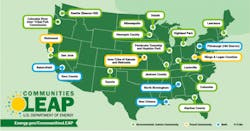US DOE to help 22 communities find infrastructure funds for microgrids and clean energy projects
The US Department of Energy (DOE) has opened the door for 22 communities to capture federal infrastructure funds for microgrids and other clean energy projects through a program that emphasizes “place-based approaches.”
Called Communities LEAP (Local Energy Action Program), the initiative helps these cities, towns and tribes develop clean energy road maps and find funding for them from the $1.3 trillion Infrastructure Investment and Jobs Act and other federal sources.
“Communities across the country must be able to take advantage of these historic investments in clean energy infrastructure, energy efficiency and clean transportation,” said Mitch Landrieu, White House senior adviser and infrastructure coordinator. “Technical assistance programs like Communities Leap will help ensure these communities are prepared for the many funding opportunities available from President Biden’s Bipartisan Infrastructure Law as we transition to a clean energy economy.”
Join us at Microgrid 2022 for a special session, “Making Microgrids a Building Block of US Infrastructure and Climate Goals,” on June 1 in Philadelphia, Pennsylvania.
The DOE specifically calls out development of microgrids and energy storage as among the strategies the program will emphasize. Others are energy efficient buildings and beneficial electrification, clean energy development, clean transportation and enhanced mobility, carbon capture and storage, critical minerals recovery, and manufacturing and industry opportunities.
The program focuses specifically on bringing clean energy to disadvantaged communities and those in coal country facing hardship because of the transition to clean energy.
One of the 22 communities is New Orleans, a city hard hit by several severe hurricanes, most recently Hurricane Ida. The city wants to bring greater energy affordability and resilience to small businesses — especially those owned by minorities. The road map will attempt to coordinate work already underway in New Orleans on microgrids and renewable energy, energy efficiency, disaster preparedness, climate change mitigation and workforce development.
Bakersfield in Kern County, California, also made the list. Kern County is the second highest producing agricultural region in the United States, according to the DOE, and it already has several microgrids underway, among them a 5-MW microgrid by Concentric Power for Tasteful Selections, which grows and packages potatoes. The DOE program will explore ways to decarbonize farming and ranching and lower energy costs for low- and middle-income families.
Two other cities in California that already have microgrids are on the list — Richmond and San Jose. The Leap program will help with their electrification efforts.
Highland Park, Michigan, a three-square mile city bordered by Detroit, also made the list. The racially segregated community, which ranks in the 94th percentile for low-income status in the US, is in an energy crisis, according to the DOE. About two-thirds of its residents live without streetlights. A community action group, Highland Park-based Soulardarity, has installed 17 solar street lights, and the community has formed the Pathways to Power project to address power outages, lower energy costs and pursue other means to make the community more resilient.
The Iowa Tribe of Kansas and Nebraska was selected for the program because its reservation is at the end of its utility’s service line, a situation that can cause electric reliability issues and minimize economic development.
A neighborhood in Pittsburgh, Pennsylvania, home to the first major airport powered by a hybrid microgrid, also made the list. The DOE program will focus on Pennsylvania’s Greater Hill District, built on abandoned coal mines. A development plan for the neighborhood addresses energy burden issues, localized wealth generation and funding streams for increased neighborhood investment.
Other communities that were chosen are:
- Alachua County, Florida.
- Birmingham (North Birmingham), Alabama.
- Columbia, South Carolina.
- Columbia Inter-Tribal Fish Commission, Oregon, Washington, Idaho.
- Duluth, Minnesota.
- Hennepin County, Minnesota.
- Jackson County, Illinois.
- Lawrence, Massachusetts.
- Louisville, Kentucky.
- Mingo and Logan Counties, West Virginia.
- Minneapolis, Minnesota.
- Pembroke Township and Hopkins Park, Illinois.
- Questa, New Mexico.
- Seattle (Beacon Hill), Washington.
In its announcement of the winners, the DOE said that in 2019 renewable energy investments in the US reached $55 billion and clean energy jobs paid 25% more than the national median wage. Workers in clean energy earned a median hourly wage of $23.89 compared to the national median wage of $19.14.
Track news about how microgrids can leverage infrastructure funds. Subscribe to the free Microgrid Knowledge Newsletter.







